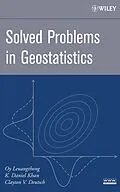This unique book presents a learn-by-doing introduction to
geostatistics.
Geostatistics provides the essential numerical tools for
addressing research problems that are encountered in fields of
study such as geology, engineering, and the earth sciences.
Illustrating key methods through both theoretical and practical
exercises, Solved Problems in Geostatistics is a valuable
and well-organized collection of worked-out problems that allow the
reader to master the statistical techniques for modeling data in
the geological sciences.
The book's scope of coverage begins with the elements from
statistics and probability that form the foundation of most
geostatistical methodologies, such as declustering, debiasing
methods, and Monte Carlo simulation. Next, the authors delve into
three fundamental areas in conventional geostatistics: covariance
and variogram functions; kriging; and Gaussian simulation. Finally,
special topics are introduced through problems involving utility
theory, loss functions, and multiple-point geostatistics.
Each topic is treated in the same clearly organized format.
First, an objective presents the main concepts that will be
established in the section. Next, the background and assumptions
are outlined, supplying the comprehensive foundation that is
necessary to begin work on the problem. A solution plan
demonstrates the steps and considerations that have to be taken
when working with the exercise, and the solution allows the reader
to check their work. Finally, a remarks section highlights the
overarching principles and noteworthy aspects of the problem.
Additional exercises are available via a related Web site, which
also includes data related to the book problems and software
programs that facilitate their resolution. Enforcing a truly
hands-on approach to the topic, Solved Problems in
Geostatistics is an indispensable supplement for courses on
geostatistics and spatial statistics a the upper-undergraduate and
graduate levels.It also serves as an applied reference for
practicing professionals in the geosciences.
Autorentext
Oy Leuangthong, PhD, is Assistant Professor in the
Department of Civil and Environmental Engineering at the University
of Alberta, Canada. Dr. Leuangthong conducts extensive research on
the use of geostatistical methods for improving mineral resources
and petroleum reservoirs.
K.Daniel Khan, PHD, is an Earth Scientist with Chevron
Corporation, specializing in reservoir modeling. Dr. Khan's work
focuses on modeling heterogeneity and fluid flow processes using
geostatistical and inverse techniques.
Clayton V. Deutsch, PHD, is Professor in the Department
of Civil and Environmental Engineering at the University of
Alberta, where he is also Director of the School of Mining and
Petroleum Engineering. He has over twenty years of experience in
both academia and industry. Dr. Deutsch has published over 100
articles in his areas of research interest, which include modeling
heterogeneity and uncertainty in petroleum reservoirs and mineral
deposits.
Zusammenfassung
This unique book presents a learn-by-doing introduction to geostatistics.
Geostatistics provides the essential numerical tools for addressing research problems that are encountered in fields of study such as geology, engineering, and the earth sciences. Illustrating key methods through both theoretical and practical exercises, Solved Problems in Geostatistics is a valuable and well-organized collection of worked-out problems that allow the reader to master the statistical techniques for modeling data in the geological sciences.
The book's scope of coverage begins with the elements from statistics and probability that form the foundation of most geostatistical methodologies, such as declustering, debiasing methods, and Monte Carlo simulation. Next, the authors delve into three fundamental areas in conventional geostatistics: covariance and variogram functions; kriging; and Gaussian simulation. Finally, special topics are introduced through problems involving utility theory, loss functions, and multiple-point geostatistics.
Each topic is treated in the same clearly organized format. First, an objective presents the main concepts that will be established in the section. Next, the background and assumptions are outlined, supplying the comprehensive foundation that is necessary to begin work on the problem. A solution plan demonstrates the steps and considerations that have to be taken when working with the exercise, and the solution allows the reader to check their work. Finally, a remarks section highlights the overarching principles and noteworthy aspects of the problem.
Additional exercises are available via a related Web site, which also includes data related to the book problems and software programs that facilitate their resolution. Enforcing a truly hands-on approach to the topic, Solved Problems in Geostatistics is an indispensable supplement for courses on geostatistics and spatial statistics a the upper-undergraduate and graduate levels.It also serves as an applied reference for practicing professionals in the geosciences.
Inhalt
Preface and Acknowledgments.
1. Introduction.
1.1 Plan of this Book.
1.2 The Premise of Geostatistics.
1.3 Nomenclature.
2. Getting Comfortable with Probabilities.
2.1 Parametric Probability Distributions.
2.2 Variance of Linear Combinations.
2.3 Standardization and Probability Intervals.
3. Obtaining Representative Distributions.
3.1 Basic Declustering.
3.2 Debiasing with Bivariate Glaussian Distribution.
3.3 Comparison of Declustering Methods.
4. Monte Carlo Simulation.
4.1 Impact of the Central Limit Theorem.
4.2 Bootstrap and Spatial Bootstrap.
4.3 Transfer of Uncertainty.
5. Variograms and Volume Variance.
5.1 Geometric Anisotropy.
5.2 Variogram Calculation.
5.3 Variogram Modeling and Volume Variance.
6. Kriging.
6.1 Stationary Kriging.
6.2 Nonstationary Kriging.
6.3 Screening Effect of Kriging.
7. Gaussian Simulation.
7.1 Bivariate Gaussian Distribution.
7.2 Conditioning by Kriging.
7.3 Gaussian Simulation.
8. Indicators.
8.1 Variogram of Objects.
8.2 Indicator Variograms and the Gaussian Distribution.
8.3 Indicator Simulation for Categorical Data.
9. Multiple Variables.
9.1 Linear Model of Coregionalization.
9.2 Gaussian Cosimulation.
9.3 Multiscale Cokriging.
10. Special Topics.
10.1 Decision Making in the Presence of Uncertainty.
10.2 Trend Model Construction.
10.3 Multiple Point Statistics.
11. Closing Remarks.
Bibliography.
Index.
